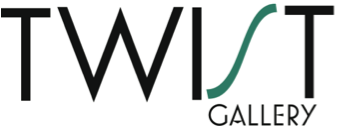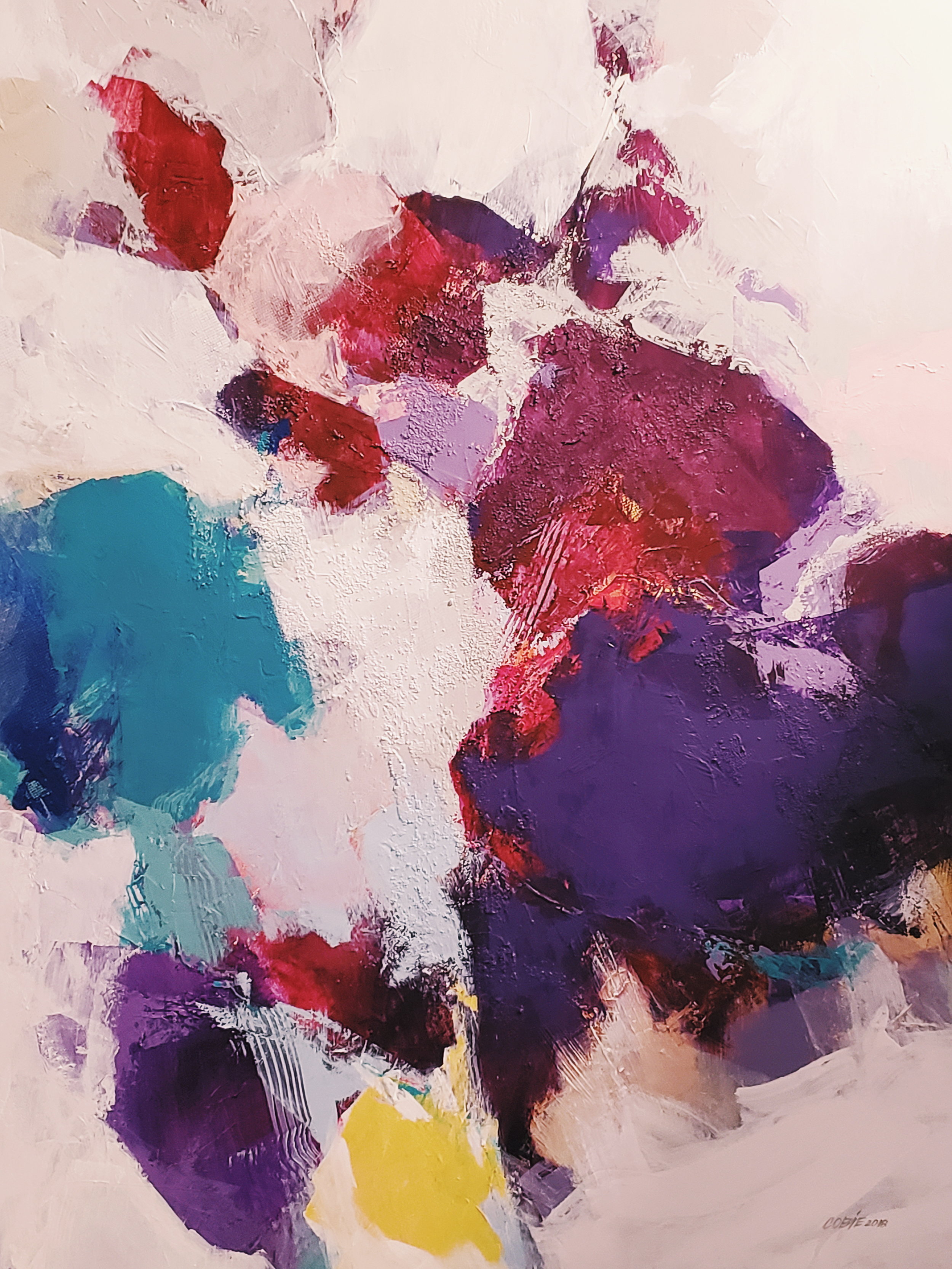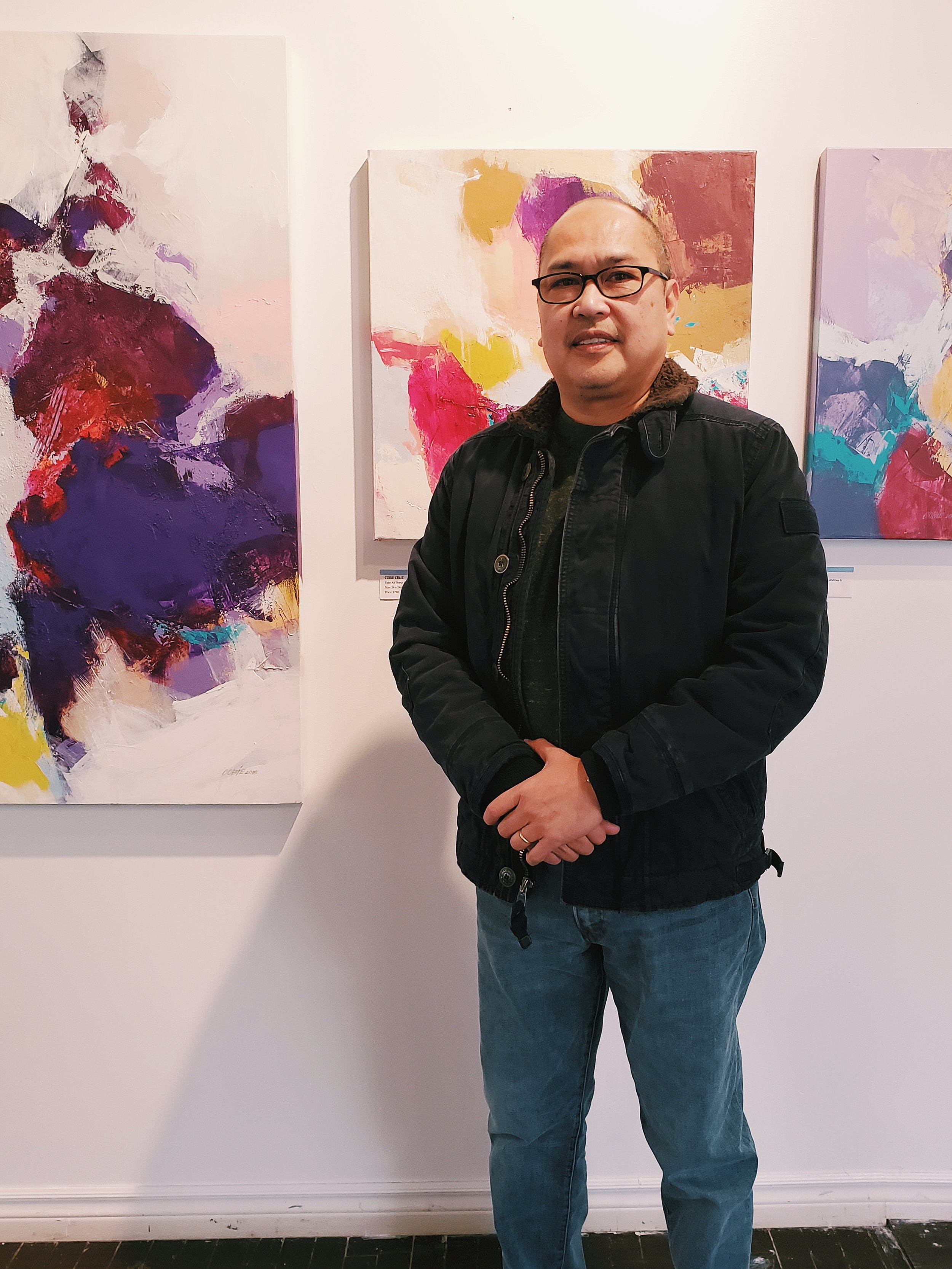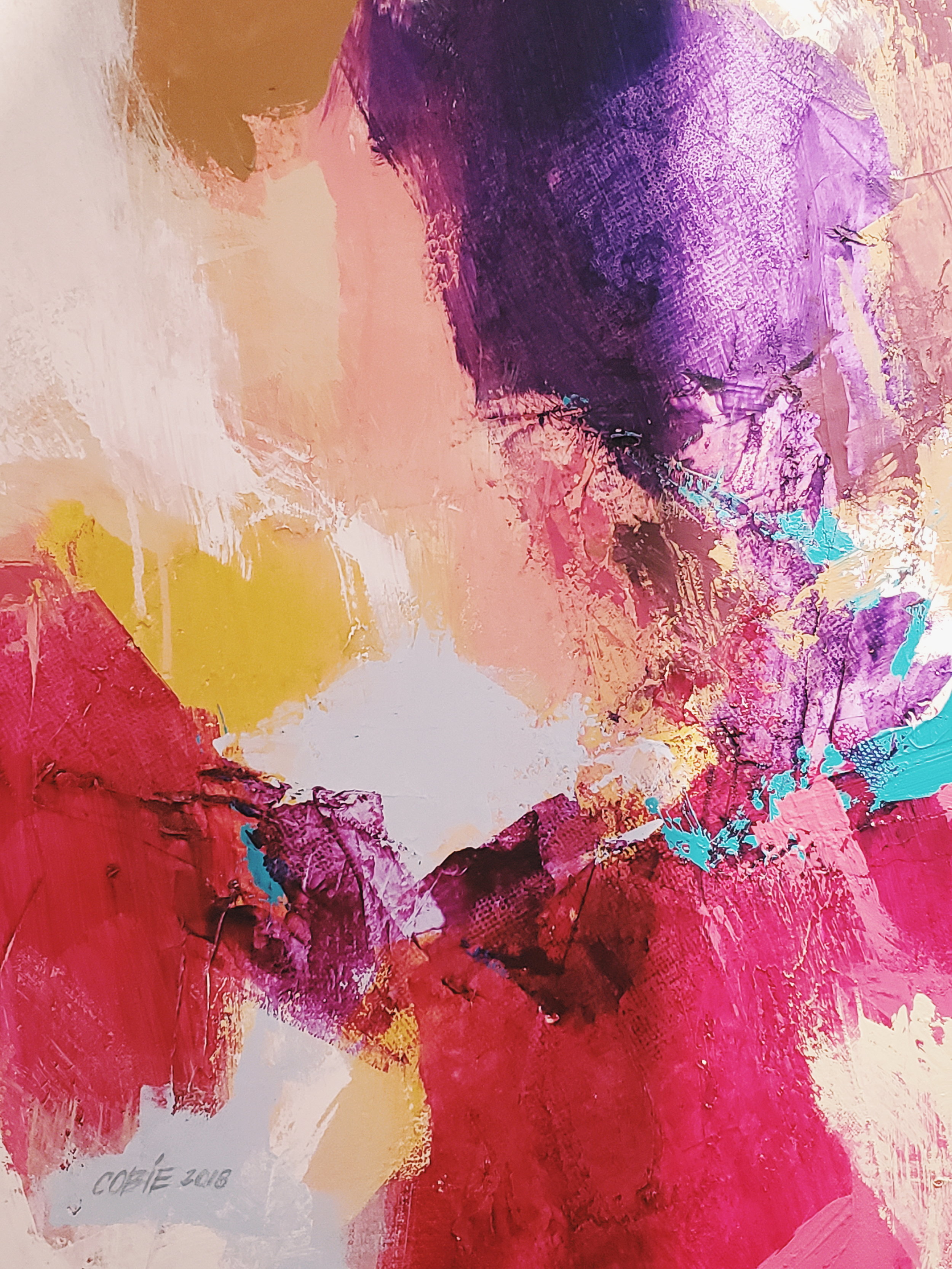November at Twist has been all about abstract art. Meet Cobie Cruz, one of the amazing artists in our group exhibition. Vibrant colours and bold strokes are just a taste of what you’ll get from this artist.
Q: What inspires your art?
A: For me I think it’s seeing a lot of colours around me. I love colours, I love textures, I like brush strokes. Most of the time before I start, I get inspirations from all sorts of media. For example, just a simple picture of a poster. Sometimes when I drive by a gas station, you see big posters there. Sometimes I see the particular image, the composition, whether there’s a person standing, or person promoting the poster. I see that composition and the colours in it like an abstract. That’s how I start.
Q: Can you talk about your process? What tools do you use to create?
A: I normally start applying modeling paste. Modelling paste allows me to add textures and details. I just apply without thinking of anything. I just apply on the white clean canvas and then sometimes I let it dry and add a little more later, a thin layer of the modelling paste. It gives me all sorts of textures. Sometimes I use a simple cleaning brush and once I apply the modelling paste, I scrape the cleaning brush onto it and it creates the vertical, diagonal strokes or whatever I want to do. It’s a stroke I freely apply.
After that, that’s when I apply the colours that I have seen around me. I start, in my mind, with three or four colours. I apply it and sometimes fill the canvas with 3 or 4 colours on it. That’s normally my first stage. I freely do my brush strokes without thinking of anything else. Nothing.
Stage 2 of the process is what I call the push and pull. When I say push, I add more colours that I think lack on the stage 1. The pull that I’m talking about is editing it, meaning that if I find that the colour red is too much, I’ll paint white over it to lessen the red. Sometimes if I find it lacks red, I’ll push it back. When I pull it that’s when I subtract or edit the colour.
Stage 3, that’s when I start to smile. When I feel that I am smiling already. Stage 3 is when I just do the final touches. That’s the process that I always apply to all of my paintings.
Q: When did you first discover art? Are you self-taught or did you go to school for it?
A: At an early age of I think 8 or 9. Seeing my dad work at an artist also, it runs in the family. I saw him working in an advertising agency and at the same time painting. He was a realist and I think I was exposed to his art that when I was 9 years old. I started doodling and I discovered that I can draw and paint. I remember my dad allowed me to use his leftover paints because art materials are really expensive.
I thought I had fun doing that when I was younger and then couple of years later, I clearly remember that I knew what I was going to take up in university and it was fine arts. I majored in advertising, but my dad encouraged me to take up painting as my major. But I said no, I think can learn painting on my own, just watching him, just loving the colours around me. I think that’s how it started. I didn’t feel bad that I didn’t follow his advice because right now I am painting.
I went to advertising industry after university, it was only until the late 90s I started painting. I used to paint realistic clouds. Then after that I remember I said in the late 90s, if I am going to be a visual artist, I’m not going to be like my dad who is a realist. He painted flowers, rocks, fields, he loves those earth tone feels where green is the guide. I even asked permission from my dad that if I’m going to be a visual artist, can I do abstract. “Absolutely” he said. “I just want you to paint, I don’t want you to let go of your talent. I believe you have the talent.”
I was able to have my first one man show in 2000 and a few years later my second one.
Q: What is your person goal as an artist?
A: Besides the money. I’m not going to lie to you, beside the finances that I can acquire from painting, on the human side, I want to see people smile, at least smile at my work. I think that one is already a real goal I have achieved. Hopefully they will like it and eventually go to the financial side, but the goal is to create art. It sounds cliché but every time I finish one piece for instance, like I said, on my own if I feel like there’s a smile on my face already, that’s a goal.
Q: How do you title your artworks?
A: When I title my artwork it’s not an individual thing, it’s a series. When I paint, I want to make sure I have a series, I’m not going to paint this colour scheme and then later on another colour scheme. It’s like having a theme.
Q: Do you have a particular piece that has a special connection to you?
A: Yeah, but you know what? That piece wasn’t sold. I have a lot of paintings that I really love that have stayed in my art studio. I remember one artist friend of mine said it’s natural that you have your favourite painting, but it doesn’t get sold. It’s like music, the melody flows and when the melody flows very well you tend to like it, you tend to keep it to yourself. It’s like your heart talking to you, that this is the kind of music you like. That goes for my paintings as well. The composition, the colours are flowing smoothly. It’s like my eye is flowing fluidly, it’s not jumping from one spot to another although sometimes there are paintings that I’ve done that my eyes wander. It’s like my eyes are exploring. That’s also a good indication for me that I love my creation.
Q: Who are some of your favourite artists?
A: Robert Motherwell is one. De Kooning is one. I have some influence from his drippings even though I don’t apply it. During my early stage when I was painting, I was influenced from De Kooning’s drippings and then later on I discovered Robert Motherwell. He had this stroke that’s very similar to my strokes. I thought of studying his strokes. If there’s an artist I’m influenced by I think it’s from those two artists. I think they’re the 50s artists.
Q: What is it like to be an artist in today’s world?
A: To be honest, there’s a lot of artists in the past fifteen years. Maybe because I am already exposed to it in the community, there’s artist from young to old generations. Again, another cliché, it’s passion. In the morning, I wake up and after doing my responsibilities, because I have another job, if only I can make this painting my full-time job, I would be the happiest visual artist in the world. I love to paint. I get inspired from painting as well. Especially if I’m in the zone, I feel so light. It’s like I want to forget the other responsibilities and I want to paint the whole day. Although sometimes it’s tiring because your mind keeps working.
I have a lot of friends who are not artists and they say “wow, I think you’re the happiest person in the world.” I say why? They said because you’re doing what you want and you’re happy with it. My answer to them is yes, I’m very happy but at the same time it’s tiring, my mind keeps thinking. Am I complaining? I say no. It’s not that I simply sit down or stand up. I let my hands do the strokes with the help of the brush right, but it’s tiring as well. But at the end of the day, sometimes after two hours, three hours, when I feel like I have this smile on my face I feel like it’s okay.
Q: Do you find it financially challenging?
A: Right now, honestly no because I’m selling. Thank god I’m selling. People appreciate my work and because of that I can sustain my painting because obviously I have to sustain it with art supplies. The challenge there is not just the money. I want to make sure people will smile when they see my paintings. That’s my biggest challenge. To be honest, money will come later on, but I have to take care of the people who will like, who will love, and will buy my paintings. That’s the challenge.




